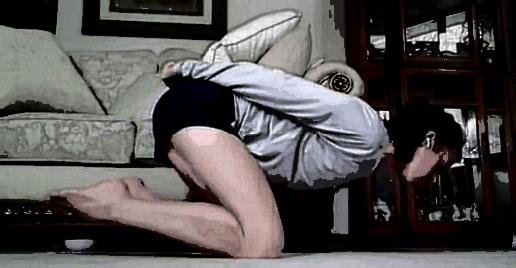
Ribs as Pelvis
The two bowls of the torso work in relation to one another. The ribs act as an upside down bucket and psoas sticks. The pelvis acts as as a rotary basin with hip handles. Should they be able to freely interact, the bucket and the basin reinforce each other’s position. Movement allows for many options of stability.
Posture is affected when one entity takes command over the other. In my own case, my desire to loosen up my pelvis forced my ribs to clamp down, pinning my sternum to my upper abs. Once released (which literally felt like uncloaking or taking off a shawl your arms clung to), I now had two compasses in which to navigate movement — the coccyx and the xiphoid. Like a rubik’s cube, turns could happen left to right and up and down, simultaneously aligning rather than relying on singular pivots.
It started with revelations on how to perform everyday things differently. Instead of further folding into that coupled rib hinge, I could open and drive down while the ribs drifted up:
View this post on Instagram
Traps do not marionette the ribs, but rather sink down with the scaps. The ribs release rather than get suctioned into compression.
Letting go of that xiphoid sticking point allowed the pelvis to also roll away, creating length through the front side of the abdomen:
View this post on Instagram
Positional change lead to a postural change. Comfort and familiarity lead to safety to separate. Sensationally, a switch occurred from one side of the parenthesis to the other. A rounded back with tucked xiphoid (resulting from an obsession with a tucked tailbone — posterior pelvic tilt) shifted my center of mass back. My pelvis shifted back with it, causing my quads and front side to pull my ‘backpacked’ mass around. Flipping in the opposite direction, my belly and chest could lead, reestablishing my center and my pelvis underneath. Now when I walk, it is my hamstrings that move me; pushing from behind.
The ribs are responsible for holding themselves up.
Tethered to the anchor of the pelvis for so long, they forgot they could act like a balloon:
View this post on Instagram
Speaking of balloons, releasing the ribs did wonders for my incontinence:
View this post on Instagram
Independent ribs lengthen the system and extend the possible tipping point:
View this post on Instagram
The xiphoid can move to create a higher anchor point that lifts the hips:
View this post on Instagram
The ribs cannot only load but provide resistance against the arms:
View this post on Instagram
Finally, the ribs can press back upon the pelvis to create a reactive drive forward. The pendulum can initiate from both directions:
View this post on Instagram
Being able to separate the pelvis from the legs, the ribs from the arms, and the pelvis from the ribs offers up a multitude of combinations to orchestrate and improv with. It is as if one new piece changes the box top of the puzzle instead of creating a new cram point. Familiar patterns feel fresh and interesting; revisiting is revelatory. Perhaps the unnamed secret of youth is to keep broadening your awareness and sensitivities so that doing-and-noticing becomes an ever-increasing pleasurable experience. It is the ongoing game you never want to end.




